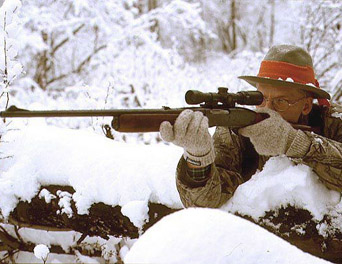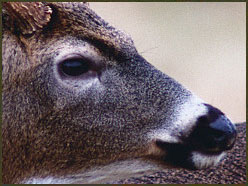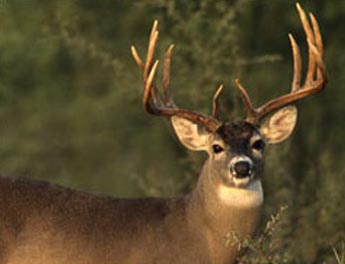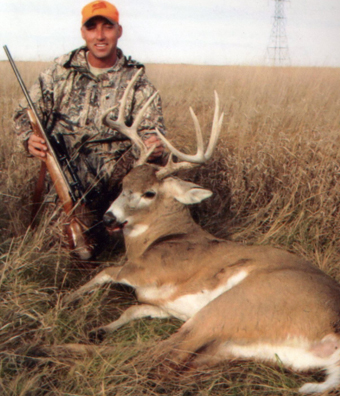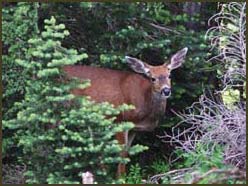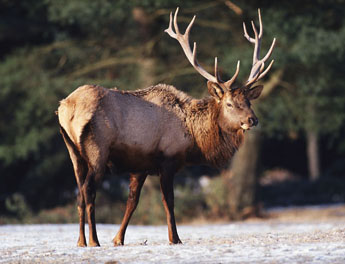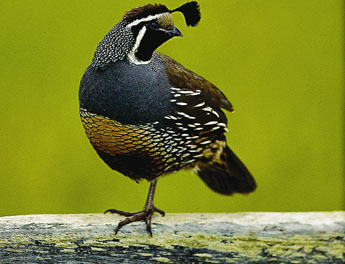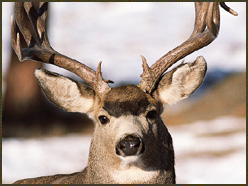Late fall can be a cold, bleak and desolate time in the woods. The foliage is long gone, save for a few withered oak leaves clinging tenaciously to their limbs, rattling in protest against the icy wind. It seems you can see forever, which only serves to accentuate the lack of game moving about and your feeling of isolation.
It’s easy to let your mind wander and dream of the recent days when whitetails were chasing does in the peak of the rut, but don’t. While the rut may be the most exciting time of the year for a deer hunter, your chances of bringing home a trophy don’t end with its conclusion. In fact, your odds may actually increase. By adjusting your tactics to fit the deer’s changing behavior, you may experience your best odds for tagging a real wall-hanger late in the season.
1. Time Your Hunt
with maturity and experience comes patience. After surviving several hunting seasons, mature bucks have learned that being in the open during daylight is dangerous. They’ve also learned not to waste energy chasing does until the time is right. Early in the rut, a few does start coming into estrus and bucks are moving throughout the day looking for a hot female. A lot of bucks are killed at this time, but they’re often yearlings and middle-aged bucks. Meanwhile, the big boys are biding their time, waiting for the real thing. Then most of the does are bred in a very short time span. As the breeding phase winds down, hot does become difficult to find. Younger bucks are either worn down or driven home in the back of someone’s pickup. But the older bucks are still in breeding mode.
Convincing evidence comes from Dr. Mickey Hellickson, chief wildlife biologist for the famed King Ranch in Texas. Hellickson conducted a three-year study of 125 radio-collared bucks and found that buck activity was highest in January, during the post-rut period. He also found that a lot of that activity actually occurred during the day.
Though mature bucks in search of does will be on the move all day, they will stick to cover. In the agricultural land of the Midwest or the open country of the West, look for them along narrow, vegetated river bottoms and windrows. Set up along well-worn deer trails, especially in wooded strips connecting larger blocks of timber. River bends offer an ideal setup if you can get where prevailing winds are blowing your scent away from cover.
In mountainous terrain, deer travel funnels might be saddles, benches, a ridge point or the head of a ravine. In extensively forested areas, these features might be more subtle, but they’re there. A topo map and an aerial photo can be invaluable in helping you locate them. Once you find the right terrain, head out and be prepared to spend the entire day. I’ve queried guides from various places across the country, and all have observed that the majority of their big bucks are taken between 10 a.m. and 1 p.m. Pack a lunch, bring extra clothes and stay alert.
[pagebreak] 2. Catch the Second Rut
does that are not bred during the first rut will come into estrus again approximately 28 days later. Make note of when the first rut occurred, count the days and plan on being in the woods at that time. In some areas, the second rut may actually be better for tagging a mature buck.
“In the Midwest, as many as eighty to eighty-five percent of does reach sexual maturity as fawns,” says Hellickson. “Because they’re immature, they’re not coming into heat until later in the breeding season, which means late December or early January.”
Although activity will not be as intense, you can still revert to rut-hunting tactics you used earlier in the season like rattling, calling and using scents. Studies from the University of Georgia and Texas A&M-Kingsville; showed that although responses to rattling dropped in the post-rut, the highest number of responses were by mature bucks. Furthermo, drawn-out, soft rattling worked best in the post-rut. Tickle the tines together more gently and use longer sequences.
The same applies to calling. You should still be using rut calls like a doe bleat or a tending buck. Just be less aggressive. This is also a good time to bring those estrous doe scents back out. As some does come into heat again, bucks will once more be searching for that “hot” scent.
3. Target Winter Habitat
when we think of migration in the deer family, we usually envision vast herds of caribou trekking across the tundra or elk moving down from the snowy mountains. But whitetails, mainly those in colder climates, also migrate to traditional wintering areas, where they become concentrated. Areas that might have been largely devoid of deer early in the season can become whitetail havens after the rut, and deer often use traditional migration corridors to reach these winter yards.
In the northern forests of the Midwest and Northeast, you’ll find deer in low-lying areas dominated by mature coniferous forests-fir, hemlock and cedar. The evergreens not only reduce snow depth, making travel easier for deer, but also break the wind and keep temperature fluctuations more moderate. Areas with a southern exposure are best because they receive the most sunlight and are protected from prevailing winds. This is especially true in the Northern Plains and prairie states and provinces, which lack extensive softwood shelter.
In Northern forests, still-hunting can be effective. Once you’ve located a winter concentration area, wait until it’s light, slip in and very slowly sneak along, stopping every few yards to glass ahead for signs of a deer-a patch of brown or the flick of an ear. As you do, be mindful of the wind and try to keep the sun at your back.
Western whitetails, like mule deer, also make seasonal, altitudinal migrations from the high country down into the surrounding foothills and agricultural areas. The best areas will be densely vegetated river bottoms adjacent to high-calorie food sources like alfalfa, corn and soybeans.
[pagebreak] 4. Find Their Food
after the rut, a buck’s priorities shift from breeding to feeding. Bucks adopt an energy- conservation mode of behavior-seek out shelter, move directly between food and bedding areas and move only during warmer parts of the day.
One of the best ways for the late- season hunter to exploit this chink in the whitetail’s armor is to target concentrations of high-calorie foods. In agricultural areas this means remnant crops like corn, soybeans or milo, while in the forest it might be oak ridges or flats where there is a good mast crop. It’s important to remember that seasonal movement patterns can vary considerably from year to year depending on food availability. Make sure you scout in advance to find sources of abundant late-season food.
A more reliable tactic is to hunt late-season food plots. The most effective are those dominated by high-calorie plants like winter wheat, rye and brassica. Brassicas are large, broad-leaved plants, similar to cabbage or broccoli. When the first frosts hit, the starches in these plants begin turning to sugar, and deer relish them.
When it comes to planting your own late-season food plot, keep in mind that most wildlife seed companies have designed specific blends for such plots. You’re far better off going with one of these blends-many of which have been tailored for specific regions and for their seasonal palatability to whitetails. Follow the planting directions closely for a great food plot.
5. Hit the Hot Spots
in the 1990s, Hellickson did an analysis of whitetails entered in the Boone and Crockett Club record books. He discovered that states that delayed opening the firearm hunting seasons until after the rut’s peak accounted for nearly 10 times more entries than states with gun seasons held before or during the rut peak. He also found that states that restricted the use of firearms to shotguns recorded almost eight times more entries than states that allowed rifles. He attributed this to the shorter range of shotguns, which allowed higher numbers of bucks to survive. States like Iowa, Illinois and Kansas are prime examples. By studying the record books and seasons in other states, you may find similar hot spots that are overlooked by other hunters.
Hellickson also discovered that many entries came from bottomlands, swamps and similar terrain associated with rivers and tributaries. It suggested to him that because steep ridges, ravines and thick cover limited hunter access, more bucks lived longer in these spots and, as a consequence, got bigger. That deer use such overgrown, rugged areas for winter shelter and travel corridors rather than more open country is also a likely factor in their survival.
Trophy-buck hot spots also occur on a more local scale, especially for hunters who use bows. Among New York State’s top trophy-producing counties are Westchester and Suffolk-both little more than an hour away from New York City. Like most suburban settings, these counties are largely restricted to bowhunting. The same holds true for pockets of land throughout suburban areas across the whitetail’s range where firearms are restricted or prohibited.
Also, look to smaller parcels of land that might be overlooked by most hunters. The best ones will be surrounded by private land closed to hunting, which acts as a reservoir for big-racked whitetails.
Follow in Their Footsteps**
for northwoods hunters, one of the best advantages of late season is the likelihood of a tracking snow. It’s tough to gauge the age of sign on dry, often leaf-covered ground, but in new-fallen snow, every track is fresh. Best of all, you know there’s a deer at the other end.
The first step upon finding a track is to size up the deer that made it. A track of 4 inches or longer is almost certainly a mature buck. Sometimes width-3½ inches or more across-is an even better indicator. Note how deep the deer sank into the snow. If there are other tracks around, you can judge the relative sinking depth of each-the deeper the track, the heavier the deer.
You also need to determine how old the track is. If it snowed all night, check how much snow, if any, is in the track. If the temperature dropped suddenly overnight, try to determine if the tracks were made before or after the mercury plunged. Has snow in the track crystallized, or is it still loose? Do the tracks look like they were made in soft, wet snow or dry, frozen snow?
Once you decide to take up the track, you need to figure out how fast the deer was moving. Note whether his tracks are evenly spaced and moving in a str states with gun seasons held before or during the rut peak. He also found that states that restricted the use of firearms to shotguns recorded almost eight times more entries than states that allowed rifles. He attributed this to the shorter range of shotguns, which allowed higher numbers of bucks to survive. States like Iowa, Illinois and Kansas are prime examples. By studying the record books and seasons in other states, you may find similar hot spots that are overlooked by other hunters.
Hellickson also discovered that many entries came from bottomlands, swamps and similar terrain associated with rivers and tributaries. It suggested to him that because steep ridges, ravines and thick cover limited hunter access, more bucks lived longer in these spots and, as a consequence, got bigger. That deer use such overgrown, rugged areas for winter shelter and travel corridors rather than more open country is also a likely factor in their survival.
Trophy-buck hot spots also occur on a more local scale, especially for hunters who use bows. Among New York State’s top trophy-producing counties are Westchester and Suffolk-both little more than an hour away from New York City. Like most suburban settings, these counties are largely restricted to bowhunting. The same holds true for pockets of land throughout suburban areas across the whitetail’s range where firearms are restricted or prohibited.
Also, look to smaller parcels of land that might be overlooked by most hunters. The best ones will be surrounded by private land closed to hunting, which acts as a reservoir for big-racked whitetails.
Follow in Their Footsteps**
for northwoods hunters, one of the best advantages of late season is the likelihood of a tracking snow. It’s tough to gauge the age of sign on dry, often leaf-covered ground, but in new-fallen snow, every track is fresh. Best of all, you know there’s a deer at the other end.
The first step upon finding a track is to size up the deer that made it. A track of 4 inches or longer is almost certainly a mature buck. Sometimes width-3½ inches or more across-is an even better indicator. Note how deep the deer sank into the snow. If there are other tracks around, you can judge the relative sinking depth of each-the deeper the track, the heavier the deer.
You also need to determine how old the track is. If it snowed all night, check how much snow, if any, is in the track. If the temperature dropped suddenly overnight, try to determine if the tracks were made before or after the mercury plunged. Has snow in the track crystallized, or is it still loose? Do the tracks look like they were made in soft, wet snow or dry, frozen snow?
Once you decide to take up the track, you need to figure out how fast the deer was moving. Note whether his tracks are evenly spaced and moving in a str
